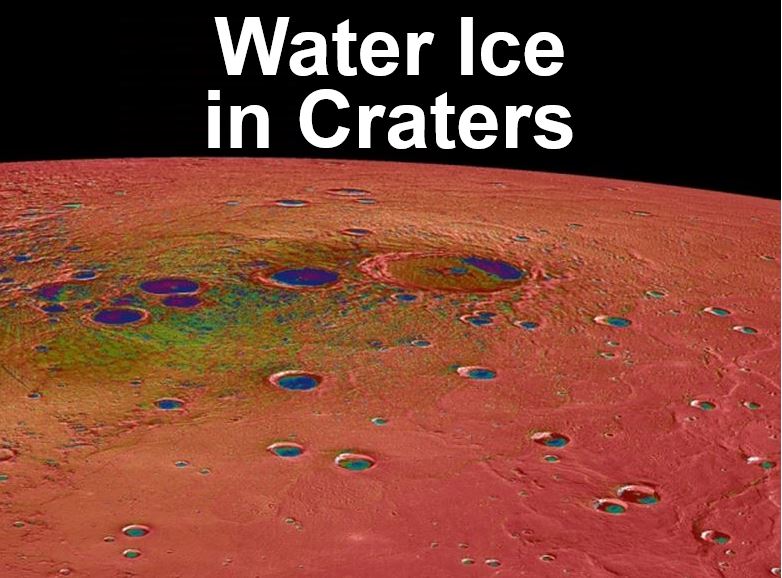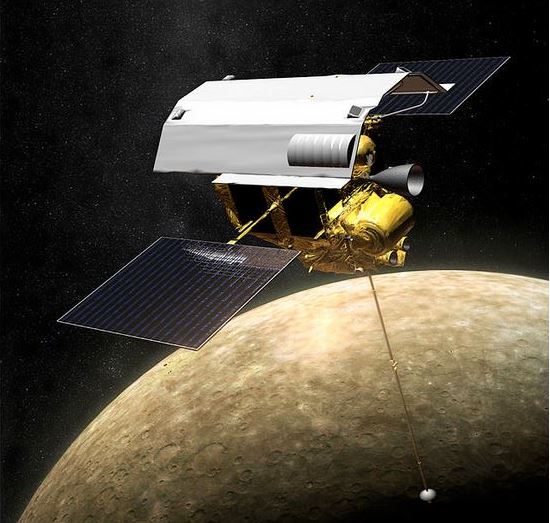According to NASA, its MESSENGER spacecraft runs out of propellant today, 30 April, and crashes into Mercury at 8,750 miles per hour or 3.91 kilometres per second, thus ending its mission which started in 2004 when it was launched from Earth to study the Sun’s nearest planet.
MESSENGER is expected to crash into Mercury’s surface in the mid-afternoon, Eastern Time, on Thursday.
The spacecraft will hit the side of Mercury facing away from Earth, so mission control will not be able to view the exact location of the collision in real time.
Before the MESSENGER (MErcury Surface, Space ENvironment, GEochemistry, and Ranging) Mission, scientists did not know much about the solar system’s smallest planet, despite it being one of our nearest neighbours.

Permanent shadows in craters on Mercury’s surface allow ice to exist there. (Image: Nature)
Associate administrator for the Science Mission Directorate at NASA Headquarters in Washington, John Grunsfeld, said:
“For the first time in history we now have real knowledge about the planet Mercury that shows it to be a fascinating world as part of our diverse solar system.”
“While spacecraft operations will end, we are celebrating MESSENGER as more than a successful mission. It’s the beginning of a longer journey to analyze the data that reveals all the scientific mysteries of Mercury.”
The spacecraft travelled for more than 6½ years before orbiting Mercury on March 18, 2011. It’s main mission was to orbit the small planet and collect data for one (Earth) year.
“The spacecraft’s healthy instruments, remaining fuel, and new questions raised by early findings resulted in two approved operations extensions, allowing the mission to continue for almost four years and resulting in more scientific firsts.”
Mercury has water ice
One of the major achievements of the MESSENGER Mission was in 2012, when compelling evidence was sent back to Earth that Mercury had abundant frozen water and other volatile materials in its permanently shadowed polar craters.
That was the year that planetary scientists started to better understand how the inner planets, including ours, obtained their water as well as some of the chemical building blocks for life.
A dark layer that covers most of the water ice deposits supports the theory that the inner planets’ water and organic compounds originated from the outer solar system, and could have led to prebiotic chemical synthesis, which eventually gave rise to life on Earth.

An artist’s depiction of the MESSENGER spacecraft in orbit around Mercury. (Image: Wikipedia)
Sean Solomon, director of Columbia University’s Lamont-Doherty Earth Observatory in Palisades, New York, MESSENGER mission’s principal investigator, said:
“The water now stored in ice deposits in the permanently shadowed floors of impact craters at Mercury’s poles most likely was delivered to the innermost planet by the impacts of comets and volatile-rich asteroids. Those same impacts also likely delivered the dark organic material.”
Several technological firsts
The MESSENGER mission, apart from providing us with an impressive list of scientific discoveries, also boasts several technological firsts, including the development of the crucial heat-resistant and highly-reflective ceramic cloth sunshade that shielded the instruments and electronics from direct solar radiation, which given Mercury’s proximity to the Sun, is very high.
NASA says this technology will help in the design and planning of future planetary missions within the Solar System.
Mission Project Manager at APL, Helene Winters, said:
“The front side of the sunshade routinely experienced temperatures in excess of 300° Celsius (570° Fahrenheit), whereas the majority of components in its shadow routinely operated near room temperature (20°C or 68°F).”
“This technology to protect the spacecraft’s instruments was a key to mission success during its prime and extended operations.”
Scientists surprised at the abundance of volatile elements
Scientists had not expected Mercury to have such a high abundance of volatile elements (liquids that evaporate readily).
Nature author Alexandra Witze quoted Sean Solomon who said:
“The big surprise was the high abundances of volatile elements. All of the ideas for how Mercury got put together predicted that it would be depleted in volatiles, much like the Moon. But instead, we see sulphur (at) ten times the average for Earth. We see sodium and potassium. We see chlorine, one of the most volatile elements that we have the ability to measure.”
“That means we really didn’t understand the particular way that Mercury became an iron-rich planet. It wasn’t a process with sustained high temperatures that drove off the volatile elements. I don’t think the final chapter has been written on what the most likely explanation is for the formation of Mercury.”
NASA Video – MESSENGER at Mercury
